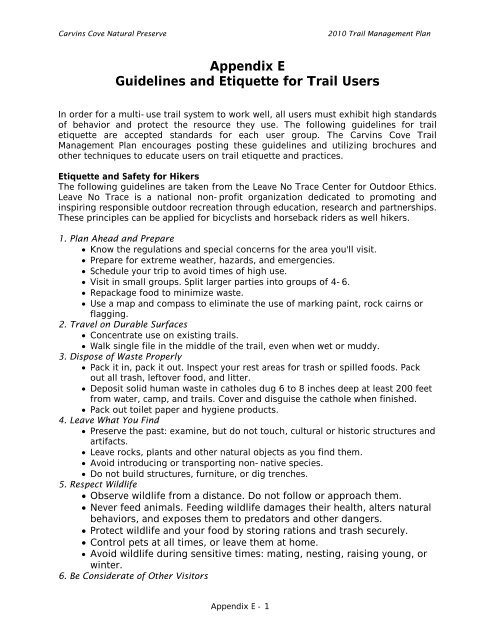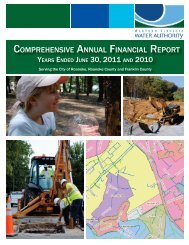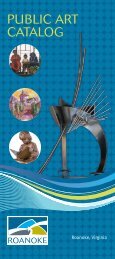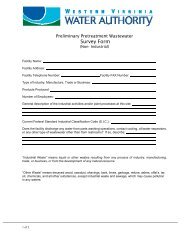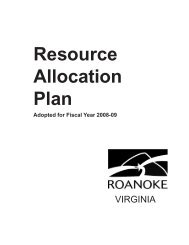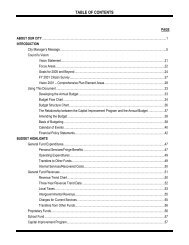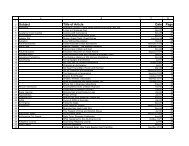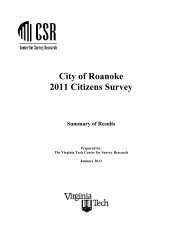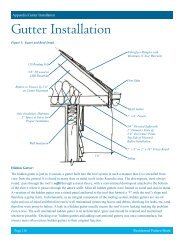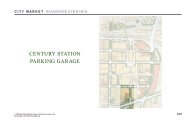Carvins Cove Trail Plan - Roanoke
Carvins Cove Trail Plan - Roanoke
Carvins Cove Trail Plan - Roanoke
Create successful ePaper yourself
Turn your PDF publications into a flip-book with our unique Google optimized e-Paper software.
<strong>Carvins</strong> <strong>Cove</strong> Natural Preserve<br />
2010 <strong>Trail</strong> Management <strong>Plan</strong><br />
Appendix E<br />
Guidelines and Etiquette for <strong>Trail</strong> Users<br />
In order for a multi-use trail system to work well, all users must exhibit high standards<br />
of behavior and protect the resource they use. The following guidelines for trail<br />
etiquette are accepted standards for each user group. The <strong>Carvins</strong> <strong>Cove</strong> <strong>Trail</strong><br />
Management <strong>Plan</strong> encourages posting these guidelines and utilizing brochures and<br />
other techniques to educate users on trail etiquette and practices.<br />
Etiquette and Safety for Hikers<br />
The following guidelines are taken from the Leave No Trace Center for Outdoor Ethics.<br />
Leave No Trace is a national non-profit organization dedicated to promoting and<br />
inspiring responsible outdoor recreation through education, research and partnerships.<br />
These principles can be applied for bicyclists and horseback riders as well hikers.<br />
1. <strong>Plan</strong> Ahead and Prepare<br />
Know the regulations and special concerns for the area you'll visit.<br />
Prepare for extreme weather, hazards, and emergencies.<br />
Schedule your trip to avoid times of high use.<br />
Visit in small groups. Split larger parties into groups of 4-6.<br />
Repackage food to minimize waste.<br />
Use a map and compass to eliminate the use of marking paint, rock cairns or<br />
flagging.<br />
2. Travel on Durable Surfaces<br />
Concentrate use on existing trails.<br />
Walk single file in the middle of the trail, even when wet or muddy.<br />
3. Dispose of Waste Properly<br />
Pack it in, pack it out. Inspect your rest areas for trash or spilled foods. Pack<br />
out all trash, leftover food, and litter.<br />
Deposit solid human waste in catholes dug 6 to 8 inches deep at least 200 feet<br />
from water, camp, and trails. <strong>Cove</strong>r and disguise the cathole when finished.<br />
Pack out toilet paper and hygiene products.<br />
4. Leave What You Find<br />
Preserve the past: examine, but do not touch, cultural or historic structures and<br />
artifacts.<br />
Leave rocks, plants and other natural objects as you find them.<br />
Avoid introducing or transporting non-native species.<br />
Do not build structures, furniture, or dig trenches.<br />
5. Respect Wildlife<br />
Observe wildlife from a distance. Do not follow or approach them.<br />
Never feed animals. Feeding wildlife damages their health, alters natural<br />
behaviors, and exposes them to predators and other dangers.<br />
Protect wildlife and your food by storing rations and trash securely.<br />
Control pets at all times, or leave them at home.<br />
Avoid wildlife during sensitive times: mating, nesting, raising young, or<br />
winter.<br />
6. Be Considerate of Other Visitors<br />
Appendix E - 1


